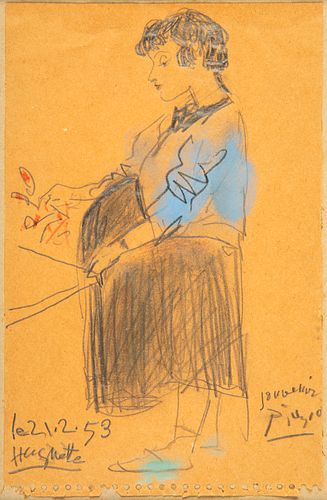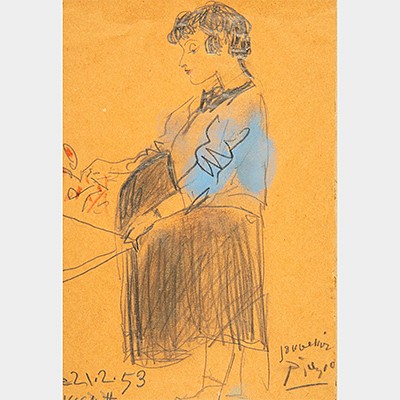PABLO PICASSO (Malaga, 1881 - Mougins, France, 1973). "Portrait of Huguette", 21.2.1953. Drawing in pencil, colored pencils and pastel on notebook she
Lot 96
About Seller
Setdart Auction House
Carrer Aragó 346
Barcelona
Spain
Setdart Subastas was born in 2004 and is currently the first online art auction in Spain with solidity, prestige and reliability guaranteed by our more than 60,000 users. Setdart has a young, dynamic and enterprising team ready to successfully manage the purchase and sale of art works through custom...Read more
Categories
Estimate:
EUR€100,000 - EUR€120,000
$108,695.65 - $130,434.78
Absentee vs Live bid
Two ways to bid:
- Leave a max absentee bid and the platform will bid on your behalf up to your maximum bid during the live auction.
- Bid live during the auction and your bids will be submitted real-time to the auctioneer.
Bid Increments
| Price | Bid Increment |
|---|---|
| EUR€0 | EUR€10 |
| EUR€200 | EUR€25 |
| EUR€500 | EUR€50 |
| EUR€1,000 | EUR€100 |
| EUR€3,000 | EUR€200 |
| EUR€5,000 | EUR€500 |
| EUR€10,000 | EUR€1,000 |
| EUR€20,000 | EUR€2,000 |
| EUR€50,000 | EUR€5,000 |
About Auction
By Setdart Auction House
Sep 20, 2021
Set Reminder
2021-09-20 08:00:00
2021-09-20 08:00:00
America/New_York
Bidsquare
Bidsquare : CONTEMPORARY ART
https://www.bidsquare.com/auctions/setdart-auction-house/contemporary-art-7482
Setdart Auction House sofia@setdart.com
Setdart Auction House sofia@setdart.com
- Lot Description
PABLO PICASSO (Malaga, 1881 - Mougins, France, 1973). "Portrait of Huguette", 21.2.1953. Drawing in pencil, colored pencils and pastel on notebook sheet. Signed, dated and titled in its lower margin. With annotations ("Souvenir"). Attached certificate of authenticity issued by Claude Picasso. Measurements: 21 x 14 cm; 59,5 x 49 cm (frame). Since Pablo Picasso discovered in 1946 the ceramics with his brilliant style in Vallauris, this village became an authentic place of cult for the Malaga-born artist. It was there that he became acquainted with the Madoura workshop, founded by Georges Ramié and Suzanne Douli after the Second World War, which led the artist to carry out a frenetic production that gave birth to more than two thousand ceramic pieces in one year. The long periods he spent in the French city, where he lived until 1955, led him to establish a close relationship with the heirs of such an important saga of ceramists: Jean Ramié, son of the Ramié-Douli couple, who joined the Madoura team in 1951, and Huguette, Suzanne's niece, who had previously worked with the Ramié family. The two collaborated regularly with the workshop teams, learning the enameling, the installation of handles and the stamped finishing of the pieces. Soon, the ties between the Picasso's and the younger generation of the Madoura's began to flourish: the young couple was very involved in Picasso's stay in Vallauris, giving way to one of the most fruitful friendships for Picasso's artistic production. Witness of them are the drawings that, like the one we are dealing with, show the most intimate part of the Ramié family: Huguette pregnant with her son Domenique, worked from the agile and sketchy stroke that characterized many of the cubist painter's sketches. This friendship was so fruitful that when Jean and Huguette formalized their marriage in 1951, Picasso and Françoise Gilot, then his companion, were present as witnesses. In fact, Huguette's close friend, Jaqueline Roque, became Picasso's last wife in 1961. Creator of Cubism together with Braque, Picasso began his artistic studies in Barcelona, at the Provincial School of Fine Arts (1895). Only two years later, in 1897, Picasso had his first solo exhibition at the café "ElsQuatreGats". Paris was to become Pablo's great goal and in 1900 he moved to the French capital for a brief period of time. When he returned to Barcelona, he began to work on a series of works in which the influences of all the artists he had known or whose work he had seen could be seen. He is a sponge that absorbs everything but retains nothing; he is searching for a personal style. Between 1901 and 1907 he developed the Blue and Pink Stages, characterized by the use of these colors and by their subject matter with sordid, isolated figures, with gestures of sorrow and suffering. The painting of these early years of the twentieth century was undergoing continuous changes and Picasso could not remain on the sidelines. He became interested in Cézanne, and based on his example he developed a new pictorial formula together with his friend Braque: Cubism. But Picasso did not stop there and in 1912 he practiced collage in painting; from that moment on, anything goes, imagination became the master of art. Picasso is the great revolutionary and when all the painters are interested in cubism, he is concerned with the classicism of Ingres. The surrealist movement of 1925 did not catch him unawares and, although he did not participate openly, it served as an element of rupture with the previous, introducing in his work distorted figures with great force and not exempt of rage and fury. As with Goya, Picasso was also greatly influenced by his personal and social situation at the time of his work. His relationships with women, often tumultuous, will seriously affect his work. However, what had the greatest impact on Picasso was the outbreak of the Spanish Civil War and the bombing of Guernica, which led to the creation of the most famous work of contemporary art. Paris was his refuge for a long time, but the last years of his life were spent in the south of France, working in a very personal style, with vivid colors and strange shapes. Picasso is represented in the most important museums around the world, such as the Metropolitan, the MOMA and the Guggenheim in New York, the Hermitage in St. Petersburg, the National Gallery in London or the Reina Sofia in Madrid.
- Shipping Info
-
In-house shipping available. Please inquire at admin@setdart.com.
-
- Buyer's Premium



 EUR
EUR CAD
CAD AUD
AUD GBP
GBP MXN
MXN HKD
HKD CNY
CNY MYR
MYR SEK
SEK SGD
SGD CHF
CHF THB
THB







